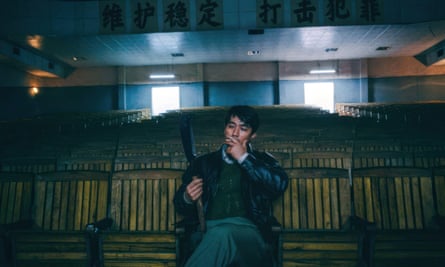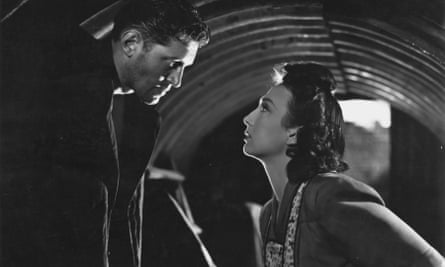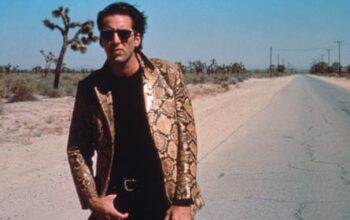Film noir was first identified at a distance. In 1946, Italian-born French critic Nino Frank coined the term to describe a cycle of coolly cynical crime thrillers produced by Hollywood earlier in that decade, but only recently available in Paris. “These ‘dark’ films, these films noirs, no longer have anything in common with the ordinary run of detective movies,” wrote Frank of films including Double Indemnity (Billy Wilder, 1944), The Maltese Falcon (John Huston, 1941) and The Woman in the Window (Fritz Lang, 1944). But the term still has legs, with films as recent, and as far removed from Hollywood, as the Chinese crime procedural Only the River Flows, which was released this summer, inspiring critics to reach for the word noir.
The first noirs were characterised by their violence, pessimism, ambiguity and the absence of sentiment, as well as the stylistic influence of European silent cinema – all of which made sense as several of the film-makers involved were émigrés, fleeing the rise of fascism. Further tropes emerged as the mode became more familiar: the femme fatale, the flashback, the antihero and his world-weary voiceover. Soon, film noir became instantly recognisable, even when mixed with the musical or the melodrama.

The internationalism of film noir begins with this return journey of film-makers, their films, and then the criticism, across the Atlantic. But the journey was not a closed loop. At the Ciné Lumière in London this month, a season entitled How to Dispose of a Dead Body: A Taste of Latin American Noir, screens noirs from Argentina, Mexico and Brazil. Opening film The Bitter Stems (1956) is a fantastically tense Argentinean thriller, in which a washed-up journalist and a Hungarian immigrant embark on a scam operation with fatal consequences. Brazilian noir Road to Crime (Flaminio Bollini, 1954) was a flagrant attempt to emulate Hollywood style, which plunges the viewer into the ganglands of the fast-growing city of São Paulo, leading to a brutally nervy climax on a skyscraper construction site. Noir’s capacity for social critique can turn any city around the world into a kind of urban hell.
“The noir style had already travelled,” says Kulraj Phullar, film historian and teacher with a special expertise in film noir. “If we see that classic noir cycle as already having international influences, German expressionism, French poetic realism, British detective fiction, it has never been static.” The idea of noir as a mode that mixes well with other genres makes it even more mobile. “The hybridity of noir from the beginning allows it to adapt to those other national cinemas and new scenarios and contexts.” Phullar cites how Hindi cinema absorbed noir in the 1950s and 1960s, leading to films such as CID (Raj Khosla, 1956), which combines noir grit with romance, comedy and the flamboyant musical numbers in which Hindi cinema excels.
The Radiance Films Blu-ray imprint has just released the second volume in its World Noir series, which collects global noirs from Japan, France and Germany. “Noir is a thread that runs through cinema history in complex ways, and allows us to explore all sorts of topics,” says managing director Francesco Simeoni, “which is very exciting from a curatorial perspective.” For example, Volume 2 includes the Yakuza heist drama Cruel Gun Story (Takumi Furukawa, 1964), which transfers the plot twists of 1950s American gangster movies into the 1960s Tokyo underworld.

This week’s rerelease of The Third Man (1949) suggests a detour closer to home: a British film noir with American stars, set in postwar Vienna, which is divided into zones controlled by different international powers, and home to travellers from across Europe and the US. Here the accent of the all-important voiceover is American, courtesy of Joseph Cotten, as is the charismatic Harry Lime, played by Orson Welles, but the story and direction are by Brits (Graham Greene and Carol Reed respectively) and its visual style, with those deep shadows and even deeper tilted angles (the cinematographer Robert Krasker was Australian), draws on Hollywood’s translation of German silent cinema. For Phullar, the significance of The Third Man is in the way that “you see and hear and feel those long journeys of film noir, perhaps more than other films of that era”. In this light, Harry Lime’s famous speech, elaborated by Welles, about how great art is produced only by countries riven by violence and turmoil, seems especially on the nose.
Those inspired to travel further into homegrown noir should check out the new season beginning this week at BFI Southbank, Martin Scorsese Selects Hidden Gems of British Cinema, co-curated with Edgar Wright, which contains such gritty British classics as It Always Rains on Sunday (Robert Hamer, 1947), a noirish and sexy drama starring Googie Withers and John McCallum as an East End housewife and her fugitive ex-boyfriend. In a recent interview for Sight and Sound magazine, Scorsese talked about how the influence of gothic literature imbues the Brit noir with gloom and horror: “There’s a toughness in the British style that doesn’t have any room for compromise.”
after newsletter promotion
The journey continues. Online, aficionados use the hashtag #Noirvember as an excuse to explore the world of noir. This November, the Film Noir Fest in Weston-super-Mare will screen noirs from around the world, not least London noirs and Mexican films of the 1950s, including El Bruto (1953), a rarely shown title directed by Luis Buñuel.
As for new films that take on the noir mantle, such as Only the River Flows, they simply create more flashbacks into film history, forging connections between film-makers and films united by a shared cinematic mood. One that lingers, dangerously.
Source: theguardian.com


